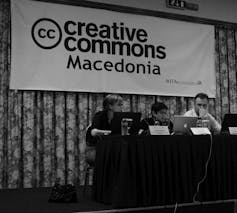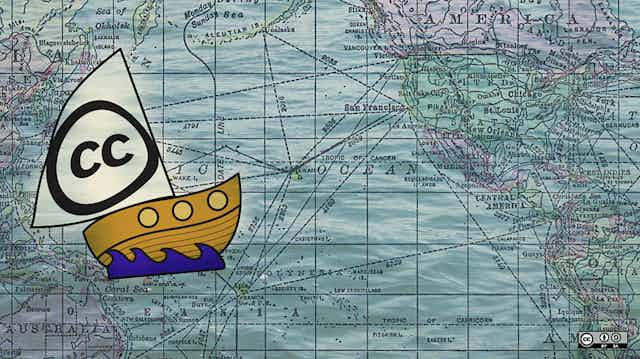The digital age has presented many and diverse challenges for copyright law. The rapid uptake of digital, networked technologies led to widespread online distribution of content, as well as the emergence of new practices and technologies that enabled digital content to be shared, reused and remixed on an unprecedented scale.
But while technology provided the capacity for sharing and reuse of content to occur on a vast scale, legal restrictions on the use of copyright material hampered its negotiability in the digital environment.
Creative Commons (CC) emerged as a direct response to the shortcomings of copyright laws and licensing practices in the dynamic, interactive and distributed internet environment.
The founders of CC recognised the power of the digital online environment, and saw the importance of enabling materials and information to flow online. They understood that the traditional approaches towards management of copyright were contributing to friction in the digital economy and that a new response was called for.
In particular, they envisioned a world where people who wanted to share their creative works could easily do so and others could reuse and remix copyright materials without the risk of being sued for copyright infringement.
How does Creative Commons work?
Creative Commons uses copyright as the platform to structure the distributed commons of creative materials which can be legally shared and reused.
The six CC licences are free, easy-to-use legal tools designed to facilitate making creative content and other copyright materials available to the public to legally share, remix and reuse.
Though the licences may rightly be seen as practical tools to be used in managing copyright, they have come to represent much more than this literal description might suggest. Their real significance is found in the outcomes achieved when the tools are applied to digital content.

The CC licences make copyright-protected content more “active” by ensuring that it is available for use and facilitating its distribution and reuse with a minimum of transactional effort.
In simple terms, the CC licences are a standardised suite of six licences that may be applied to any item among the vast range of materials and informational works that are protected by copyright.
By providing creators and users of copyright materials with the means of engaging and collaborating with others, the CC licences encourage and facilitate the release, flow and use of copyright content in the digital environment.
In applying a CC licence, a licensor eschews the “all rights reserved” approach that has long featured in traditional copyright licensing practices and reserves only those rights consistent with ensuring that the copyright material continues to be open and usable by downstream recipients.
The CC licences declare – in advance and to everyone – the uses that may lawfully be made of the copyright material and specify the conditions which must be complied with when it is used.
Each of the CC licences grants certain baseline permissions in advance, authorising use of the copyright material, subject to compliance with core conditions, as well as other general licence terms.
The baseline permissions granted by the CC licences permit the material to be copied, distributed, displayed and performed; the core condition that applies to all six CC licences is the requirement that the author of the work is to be attributed.
The first suite of CC licences (version 1.0), was released on December 16 2002. These licences were known as the “generic” licences and were based on United States copyright law.
New versions of the CC licences have been introduced periodically to improve or update the licences in light of experience or changing conditions. Version 2.0 was released in May 2004, version 2.5 in May 2005, version 3.0 in 2007 and version 4.0 in 2013.
Creative Commons around the world
In late 2003, Creative Commons launched a licence internationalisation project to promote the “porting” of the generic licences to adapt them to the laws and languages of the jurisdictions of CC Affiliates around the world.

The porting process involves more than a literal or direct translation of the text of the licences from English into the language of another jurisdiction. It also requires the redrafting of each licence so that, as far as possible, the ported licences have the same legal effect as the unported licences and are valid and enforceable under the laws of the local CC Affiliate country.
More than 60 CC Affiliate countries took up the task of porting the version 3.0 licences, and a ported version of the 3.0 licenses was produced specifically for use by intergovernmental organisations (such as the World Bank).
But porting was not feasible in several countries where CC Affiliate groups lacked the expertise or support required to undertake the work involved in producing localised versions of the licence suite.
This was the case for the Arabic language licences which were initially drafted by Jordanian lawyers Dr Rami Olwan and Ziad Maraqa in 2007; however, the changing cultural and political climate in the Middle East meant that the first Arabic language CC licences, the Egypt 3.0 licences, were not launched until late 2013.
It was against this background that the development of a new, international version of the CC licences was proposed at the CC Global Summit in Warsaw, Poland in late 2011.
The drafting of the version 4.0 licence suite began almost immediately after the Global Summit and continued for more than two years.

It involved extensive consultations between CC headquarters lawyers and international CC Affiliates, stakeholders and the broader community. During this process, many copyright and licensing issues were identified and addressed.
In drafting the version 4.0 licences, the aim was to produce an internationalised, easy-to-use version of the licences suitable for use worldwide, by simplifying both their structure and expression.
The version 4.0 international licences, launched on November 25 2013, are intended to be more interoperable with other open content licences and open source software licences, to better meet the needs of users and to extend the use of CC licences to data and public sector information.
Creative Commons, down under
In Australia, the local CC affiliate, Creative Commons Australia, was established at Queensland University of Technology (QUT) in 2004 under the leadership of Professor Brian Fitzgerald (now a member of the Creative Commons Advisory Board).
The first Australian CC licences (based on version 2.5) were launched in 2005 and were replaced in 2010 with the version 3.0 ported Australian CC licences.
Some 11 years after they were first launched, the CC licences have become the most widely used standardised copyright licensing system and are accepted as a fundamental rights management platform for the global digital economy.
Along with user-generated content, social networking and content platforms, and search engines, CC licences have become an integral part of the infrastructure of the internet.
By providing a simplified and standardised way of authorising the use of copyright materials, CC has made it possible for millions of people around the world to seamlessly distribute, share and reuse creative content which exists in digital form and is distributed online.
Although Creative Commons had its origins in the creative sector, the licences have been embraced by and are increasingly being used across a diversity of sectors including the creative industries, education, research, industry, science and government.
During the decade since they were first launched, the CC licences have proved to be an effective and simple mechanism to facilitate sharing and collaborative production of content in the digital environment.
Articles on The Conversation are licensed under Creative Commons Attribution-NoDerivatives (CC BY-ND 4.0). See our republication guidelines for more information.

